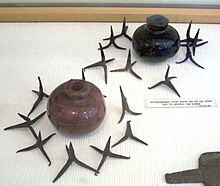A grenade is any explosive device designed to be thrown by hand. Grenade launchers
are firearms designed to fire explosive projectile grenades. There are
both grenade launchers that are integrated into other weapons (such as service rifles) and those that are built as individual weapon systems.
Design
Most grenades explode, projecting fragments, i.e., pieces of the casing, serrated wire, or an incendiary material. Some, such as smoke grenades, merely burn, releasing smoke for masking, marking, or signalling. CS riot grenades function the same way. Grenades contain an explosive or chemical filler and have a small opening for a fuse. In modern hand grenades, the fuse is lit by an internal device rather than an external flame. Grenades are not reusable.
Detonation mechanism
Timed fuse
In a timed fuse grenade, the fuse is ignited upon release of the
safety lever. Timed fuse grenades are generally preferred to hand-thrown
percussion grenades because their fusing mechanisms are safer and more
robust than those used in percussion grenades. Air burst grenades are fired from launchers and explode after a preset time corresponding with the distance to the target.
History
Incendiary grenades

Hand grenades filled with Greek fire; surrounded by caltrops. (10th-12th c. National Historical Museum, Athens, Greece)
Incendiary grenades, that use petroleum, appeared in the Eastern Roman (Byzantine) Empire, not long after the reign of Leo III (717–741).[1] Byzantine soldiers learned to use Greek fire, a Byzantine invention of the previous century, which was also in stone and ceramic jars.[1] Later, glass containers were employed. Byzantine hand grenades from the 10th to 12th centuries are on display in the National Museum at Athens. The use of petroleum for incendiary weapons, or rather variants thereof, spread to Muslim armies in the Near East, where it reached China by the 10th century.[1] Some medieval petards were small enough to be employed against enemy troops and are sometimes considered to be primitive hand grenades.
Explosive grenades

Earliest known representation of a gun (a fire lance) and a grenade (upper right), Dunhuang, 10th century CE.[2]
After the invention of gunpowder
in China, it was applied to early designs to create the world's first
explosive grenades, a prototype of the modern hand grenade.[3] Explosive grenades first appeared in Europe during the 17th century.
China
In China during the Song Dynasty (960–1279AD), weapons known as Zhen Tian Lei were created when Chinese soldiers packed gunpowder into ceramic or metal containers. In 1044, a military book Wujing Zongyao ("Compilation of Military Classics") described various gunpowder recipes in which one can find, according to Joseph Needham, the prototype of the modern hand grenade.[3]
The first cast iron bombshells and grenades did not appear in Europe until 1467.[4]
Within a couple centuries of this, the Chinese had discovered the
explosive potential of packing hollowed cannonball shells with
gunpowder. Written later by Jiao Yu (焦玉) in the mid 14th century book of the Huolongjing (火龙经, "Fire Drake Manual"),
this manuscript recorded an earlier Song-era cast iron cannon known as
the "flying-cloud thunderclap cannon" (飞云霹雳炮; feiyun pili pao). The
manuscript stated that (Needham's modified Wade-Giles spelling):
The shells (pào) are made of cast iron, as large as a bowl and shaped like a ball. Inside they contain half a pound of (shén huǒ, gunpowder). Upon detonation, the sound produced from the device was described as "claps of thunder".—[5]
This text of the Huolongjing was also important for the
understanding of the Chinese hand grenade in the 14th century, as it
provided much more detailed descriptions and even printed illustrations
of the grenade bombs used.[6]

Production of Sidolówka hand grenades in an underground Armia Krajowa facility in Lwów during World War II.
Europe
In 1643, it is possible that "Grenades" were thrown amongst the Welsh at Holt Bridge during the English Civil War. The word "grenade" originated in the Glorious Revolution
(1688), where cricket ball-sized iron spheres packed with gunpowder and
fitted with slow-burning wicks were first used against the Jacobites in the battles of Killiecrankie and Glen Shiel.[7]
These grenades were not very effective (probably because a direct hit
would be necessary for the grenade to have effect) and, as a result, saw
little use. However, trench warfare favored the grenade.
Canada
In the book, the Battle for James Bay 1686 (a translation of French
soldier Chevalier de Troyes' journal), "grenades" are referred to as
part of their inventory. De Troyes' wrote, "In the fire, we lost a
canoe, some sacks of corn, and several muskets. Some grenades which were
in one of the sacks of corn did not explode although the sack itself
was completely burned." [8]
Etymology
The word "grenade" is the French word for pomegranate.[9]
Soldiers commented on the similar shape of early grenades and the name
entered common usage. Early grenades also had round projectile fragments
within it that made it further resemble a pomegranate.

Tidak ada komentar:
Posting Komentar